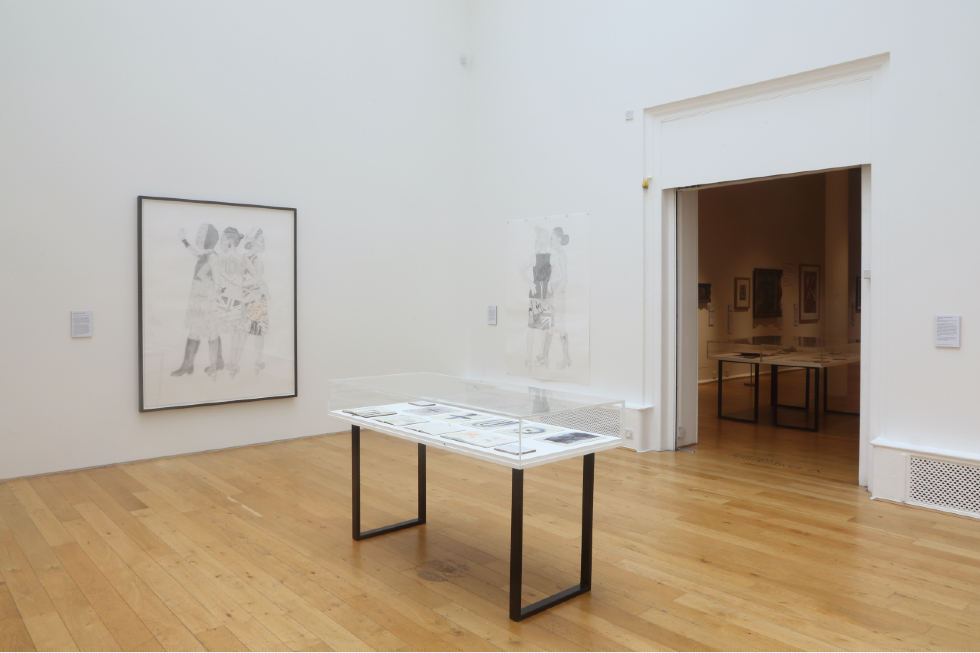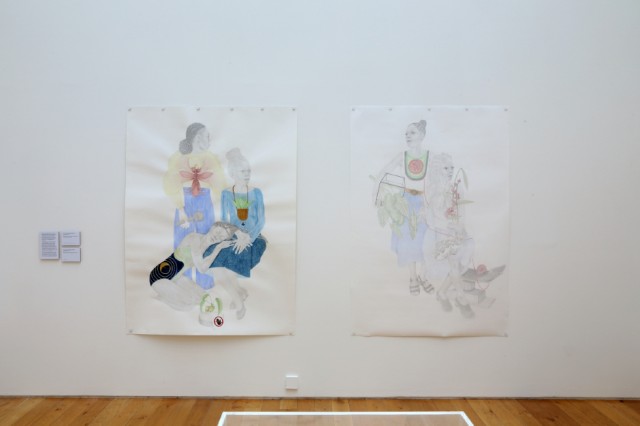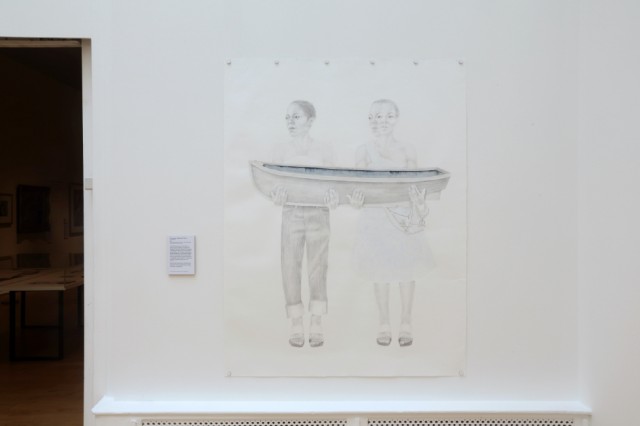Charmaine Watkiss: The Wisdom Tree – Reviewed

Sarah Feinstein on Leeds Art Gallery’s current exhibition of drawing, The Wisdom Tree, from artist Charmaine Watkiss: an ‘exquisite’ ode to Caribbean women and their histories, remembrance and endurance…
The Wisdom Tree, curated by Dr Laura Claveria, is composed of both large and smaller scale graphite and ink figurative drawings selectively enhanced with a transparent wash of watercolour. A vitrine in the centre of the room also holds a series of more experimental drawings and notebooks. A central narrative to the work has to do with history and transmission of inter-generational knowledge, what Watkiss has referred to as “memory work”, known through archetype and contemplation of our relationship to nature, in particular botany. A striking example of this are the two drawings that greet you at the entrance of the exhibition which come from a series Watkiss refers to as Plant Warrior Women.
Watkiss states: “Each have their own narrative which speak not only of their properties but also of the symbolism attached to each plant and their connection to planetary systems within our universe”(Charmain Watkiss, email to author, 4 October 2022). These plants are also part of the inherited wisdom of Watkiss’ parents’ generation, linked to medicinal traditions Watkiss herself encountered growing up. Many of the other visual motifs across the work in the exhibition are also linked to the Windrush generation and the exhibition itself is linked to the Jamaican Society Leeds’ Out of Many Festival.
Watkiss’ drawing has an immediacy and intimacy despite being produced slowly and carefully, which resonates through and with the notebooks and more experimental artworks on display. The notebooks document how she develops her artistic process, but they also provide a prompt for contemplation and communion. To see the origins of her thoughts and their trajectory into finished work feels particularly intimate in this setting. The immediacy of her work is most evident in her large-scale drawings which masterfully balance textural detail and gestural flow of her line work. Her delicately angular, linear drawing is enhanced by colour wash brushwork that seem to vibrate on the paper. This layering of material and medium combines for a uniquely rendered luminosity to her figures and a nuanced spatial plane.

Watkiss’ hand skill and technical proficiency offer testament to that effect. She has a singular talent with pattern and line, as well as the strategic use of colour. A sophisticated and engaging visual composition is not surprising for someone who has trained both as a fine artist and as a graphic designer, but her gift for devising a deeply emotive symbolic language is unique. What has stayed with me the longest is the visual and conceptual genius of drawing herself as collective subject. The artist is clear that these drawings of herself are not self-portraits, rather, character studies. Through her skilful use of composition and drawing techniques, the visual motif of her own image moves from self-portrait into a representation of a collective self.
This builds a symbolic language that effectively and affectively represents the self (or self-identity) as collective, prompting her viewer to know the self not as singular but as plural. This resonates with Watkiss’ thematic concerns with heritage practices, ecology (botany), cosmology and historical memory. The beauty of her technical skill and the richness of her symbolic motifs inspire self-reflection and dialogue with our collective pasts. A quote from one of her displayed notebooks explains this best: “Hide + reveal…what am I? What could I be? Are we living time machines [recalling] information from our ancestors?”

This resonates strongest for me in the large-scale drawing titled The Return 2018 (pictured, above) that features two figures (one with divining powers) bearing what could be seen as a boat in their arms, gazes averted. A key aspect of Watkiss’ practice involves extensive historical and archival research. In the case of The Return, she studied the cultivation and production of indigo by enslaved African people in Caribbean and American plantations. Watkiss states on the wall label that “reading accounts of plantation life was challenging, I came to a point where it occurred to me that the majority of enslaved people who died were not afforded a proper memorial – so I felt that I needed to somehow address that with this work.”
Rendering the indigo wash by hand, she used it to stain the interior of the boat, evoking both a symbolic sense of lingering and a visual reference to the sea. The exquisitely detailed patterns on the ornaments and dress of the divining figure contrast with the frenetic cross-hatching of the other figures’ trousers. Their position and solemnity in composition and comportment render them both sentinels to and bearers of remembrance and endurance. There is a demand in their presence that calls forth both mourning and protection, which Watkiss’ technical skill renders deeply textured and complex.
The Wisdom Tree is outstanding for its aesthetics and the aesthetics of its installation and display. Watkiss’ phenomenal talent in works-on-paper, and especially her hand in drawing, is undeniable. Her work also highlights that knowledge as a form of resistance; drawing to our attention that knowledge is unextractable from the land itself – it is carried within migrations forced or chosen. Perhaps this is part of ‘memory work’ and certainly a way to reconcile the natural and historical futures from our past.
Sarah Feinstein teaches at the University of Leeds in the School of Performance and Cultural Industries. Sarah’s publications include Social Capital and the Archives of Place in The Prison Memory Archive: A Case Study in Filmed Memory of Conflict, (Vernon Press, 2022). She also an editor of Full Throttle Franchise: The Culture, Business and Politics of Fast & Furious (Bloomsbury, 2023) and an editorial board member of the Journal of Festival Culture Inquiry and Analysis.
See exhibitions Charmaine Watkiss: The Wisdom Tree and Shifting Perspectives at Leeds Art Gallery (The Headrow, Leeds LS1 3AA) until 30 October 2022
Images from top: Charmaine Watkiss: The Wisdom Tree installation view; The Matriarch I, 2021 (graphite, pencil, coloured pencil, watercolour, gum, ink and Reckitts Blue on paper, on lean from the artist courtesy of Tiwani Contemporary) and The Matriarch II, 2021 (pencil, coloured pencil and Reckitts Blue on paper, private collection); The Return, 2018 (pencil, graphite powder, carbon, hand-made indigo watercolour on Canson paper, on lean from the artist courtesy of Tiwani Contemporary); The Untitled, 2016-2021 (ink, watercolour and pencil on Moleskin notebooks, on lean from the artist courtesy of Tiwani Contemporary). All artworks Charmaine Watkiss
All photography courtesy Simon Warner, with thanks





